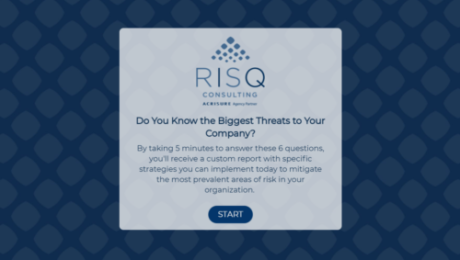The RISQ RECAP – April 18th – April 22nd, 2022
April 18th – April 22nd, 2022
Each week, you’ll find specially curated news articles to keep you up to date on the ever-evolving world of insurance and risk management. The articles are divided out between items relevant to Property & Casualty, Employee Benefits/Human Resources, and Compliance. We’ve included brief summaries of each item as well as a link to the original articles.

PROPERTY & CASUALTY
‘Zero-Day’ Hacks Hit Record in 2021, Google Researchers Say
“Hackers exploited a total of 58 zero-day flaws impacting major software providers in 2021, according to a report published April 19 by Google’s Project Zero, a team of elite bug hunters. That compares to 25 flaws in 2020 and 21 in 2019.” Full Article
– Insurance Journal

EMPLOYEE BENEFITS, HUMAN RESOURCES, & COMPLIANCE
Judge Ketanji Brown Jackson Is Confirmed As Next SCOTUS Justice “On April 7, 2022, the Senate confirmed the nomination of Judge Ketanji Brown Jackson to fill the next term’s vacancy on the bench with Justice Stephen Breyer’s upcoming retirement. In an often- contentious confirmation process that included questions lobbed from Republican senators on Judge Jackson’s position on child pornography, critical race theory, court-packing, transgender rights, and her role as a public defender for Guantanamo Bay detainees, Jackson was confirmed 53-47 with bipartisan support.” Full Article – Littler Mendelson
Paying Employees In Cryptocurrency: Is That lawful? “In recent years, more consumers, merchants, and financial institutions have accepted cryptocurrency as a form of payment for everyday products and services. Last November, mayors of two major U.S. cities signaled what may be the next phase of cryptocurrency’s melding into the mundane, when they announced they would accept paychecks in cryptocurrency. On Twitter, Mayor Francis Suarez of Miami said he would accept his next paycheck in Bitcoin, to which Mayor Eric Adams of New York responded that he would accept his first three paychecks in Bitcoin.” Full Article – Morrison Foerster
NLRB GC Seeks Dramatic Change To Employer’s Right To Speak To Employees About Unionization At Work “For decades, employers had been free to gather employees to discuss – in a non-coercive manner – the employer’s views on unionization, and had been free to share with employees what employees’ rights were with respect to the same. Earlier today, the NLRB General Counsel issued a memorandum declaring her intent to attempt to overturn this nearly 75 years of National Labor Relations Board precedent regarding an employer’s ability to speak to employees. In GC Memorandum 22-04, issued on April 7, 2022, argues that mandatory “captive audience” meetings and even simple one-on-one conversations during work are unlawfully coercive.” Full Article – Proskauer Rose LLP
Although Regular Attendance May Be an Essential Function, Leave May Still Be Required “The U.S. Court of Appeals for the Sixth Circuit rejected an employer’s argument that the employee was unable to perform any of her essential job functions, including attendance, as of the date of her termination, and was therefore not entitled to the protections of the Americans with Disabilities Act. As the Sixth Circuit noted, “To accept [the employer]’s supposed rule, an employee requesting medical leave could always be terminated if she were unable to work at the time of her request. But that cannot be the case because … medical leave can constitute a reasonable accommodation under the ADA.” Full Article – Shawe Rosenthal
Federal Court Dismisses Disability Discrimination Suit Based On Employee’s CBD Use “A federal court in Indiana dismissed an employee’s lawsuit after he tested positive for marijuana due to alleged CBD use and claimed that his termination was discriminatory on the basis of a disability. Rocchio v. E&B Paving, LLC, and Int’l Union of Operating Engineers Local 103, Case No. 1:20-cv-00417 (S.D. Indiana March 31, 2022).” Full Article – Jackson Lewis
Sick Of State And Local Paid Sick Leave “For employers with employees in multiple states or cities, designing a uniform paid sick leave policy that treats all employees equally is often the hardest part of updating an employee handbook. State and local paid sick leave laws often have different eligibility, accrual, usage, notice, and carryover requirements. Currently, about twenty-two states have a paid sick leave requirement. In addition, various cities and towns within these same states may have their own paid sick leave requirements.” Full Article – Masuda Funai Eifert & Mitchell Ltd

STATE & INTERNATIONAL COMPLIANCE
In addition to the RISQ Review, RISQ Consulting also provides a resource that features changes and updates to State and International Compliance measures. We’ve included brief summaries of each item below, and also provided links to the original articles if you’d like to read further.
Washington
Washington Revises Its Pay Transparency Law to Require Proactive Salary Disclosure
“Governor Jay Inslee signed Senate Bill (SB) 5761, updating Washington’s existing pay transparency law. Previously, after an employer made an initial job offer to an external applicant, the employer was required to provide the minimum wage or salary to the applicant if the applicant requested the information. Under the revised law, an applicant’s request is no longer required.” Full Article
– Jackson Lewis
Massachusetts
Don’t Be Late on Wage Payments To Terminated Employees In Massachusetts
“The Massachusetts Supreme Judicial Court (SJC) issued a surprising decision on April 4, holding that an employer is strictly liable for treble damages if it fails to make timely wage payments, regardless of whether the employer remedies the violation prior to the employee asserting a wage claim.” Full Article
– Day Pitney
New York
New York City Issues Guidance on Required Salary Disclosures In Job Postings
“A new “NYC Salary Disclosure Law” will soon require employers to include a good faith salary range for every job, promotion, or transfer opportunity advertised. While the NYC Salary Disclosure Law is scheduled to take effect on May 15, 2022, it may now be pushed out to November 1, 2022 due to a recently introduced bill that would amend the new law, including the effective date.” Full Article
– Goodwin Procter
Ohio
New Ohio Law Revamps the Landscape of Overtime Exemptions and Collective Action Procedures
“On Governor Mike DeWine signed Senate Bill 47 (“SB 47”) into law, signaling significant changes to overtime exemptions in the state and restructuring the procedure by which an employee may join a collective action for alleged state overtime violations.” Full Article
– Benesch Friedlander Coplan & Aronoff LLP
D.C.
D.C.’s Noncompete Ban Is Delayed Until October 1, 2022
“The District of Columbia passed arguably one of the most sweeping non- compete bans in the country. In order to consider some amendments to address serious concerns from the business community, however, the effective date of this law was previously delayed until April 1, 2022 and, as the amendments are still pending, now has been further delayed until October 1, 2022.” Full Article
– Shawe Rosenthal
- Published in Blog
The Impact of Employee Mental Health and Well-being on Workplaces
This article is from RISQ Consulting’s Zywave client portal, a resource available to all RISQ Consulting clients. Please contact your Benefits Consultant or Account Executive for more information or for help setting up your own login.
Employee well-being refers to the overall state of employees’ physical, mental, social and financial health, which can often be influenced by various workplace dynamics (e.g., workload, connections with co-workers and available resources).
While employee well-being plays a key role in employee retention, it also has a significant impact on business performance. As a result, it’s vital for organizations to take employee well-being seriously and do what they can to foster a culture that promotes well-being.
The following article provides more information on employee well-being and outlines several workplace well-being initiatives for employers to consider.
The Important Role of Mental Health in Employee Well-being
Over the years, many organizations have attempted to promote employee well-being by offering workplace solutions aimed solely at maintaining physical health. These solutions may include serving nutritious meal options on-site, offering smoking cessation programs or providing discounted memberships to local gyms.
While such solutions can certainly help employees make healthier lifestyle choices and reduce their risk of chronic illnesses, promoting employee well-being requires organizations to develop initiatives that address all aspects of workers’ overall health and happiness. Specifically, employees’ mental health must be considered.
Mental health consists of individuals’ emotional, psychological and social well-being. It affects how individuals communicate, form relationships, contribute to their communities and cope with adversity. In times of distress, individuals may suffer from poor mental health. Emotions associated with poor mental health include grief, stress, sadness or anxiousness.
It’s important to note that mental health differs from mental illness. In particular, emotions stemming from poor mental health are not diagnosable conditions but rather temporary feelings. On the other hand, mental illnesses pertain to a wide range of clinical mental health disorders (e.g., anxiety and depression). These disorders are chronic and affect how individuals think, behave and function in their daily lives. Yet, individuals who experience prolonged periods of poor mental health may eventually develop mental illnesses.
In any case, mental health is a key factor in determining employees’ well-being—one that organizations can’t afford to ignore. In fact, recent research from the Centers for Disease Control and Prevention (CDC) found that nearly three-quarters (71%) of U.S. adults experience at least one adverse symptom of stress (e.g., feeling overwhelmed or anxious) each year. Furthermore, mental health can make a difference in employees’ physical health. According to the CDC, poor mental health can increase individuals’ likelihood of developing a range of chronic conditions, such as diabetes and heart disease.
Considering these findings, it’s clear that employers must account for employees’ mental health when addressing their overall well-being.
How Employee Well-being Impacts the Workplace
Employees’ mental health and well-being can impact employers in various ways. Here are some key business objectives that may be influenced by overall workplace well-being:
- Business performance—Employee well-being can make all the difference in business performance. According to the National Center for Biotechnology Information (NCBI), mental health concerns in the workplace can contribute to increased absenteeism rates, lost productivity, decreased customer satisfaction and reduced profits. In addition, the NCBI reported that work-related stress is a leading cause of poor job performance among employees, negatively affecting employers as a whole.
- Stakeholder perception—Apart from business performance, employee well-being can also impact stakeholder perception. According to a recent report from the Harvard Business Review, the vast majority (91%) of working adults believe that a company’s culture should support mental health. As such, employers who disregard their employees’ mental health and well-being are more likely to be perceived poorly by stakeholders, resulting in reduced workplace morale, reputational damages and lost business. Such negative stakeholder perception could have lasting impacts on an employer’s brand, limiting its ability to attract top talent and remain profitable for the foreseeable future.
- Workplace safety—If organizations encounter employee mental health and well-being concerns on-site, workplace accidents and related injuries are likely to follow suit. According to the National Safety Council, instances of both moderate and severe mental health distress have been linked to a greater risk of workplace accidents. This is likely because employees facing mental health concerns are often less focused, engaged and aware of potential safety hazards, resulting in poor decision making and unnecessary risk-taking. Taking a closer look at specific mental health concerns, between 60% and 80% of workplace accidents stem from workers experiencing stress-related distractions or fatigue on the job, according to research from Eastern Kentucky University. These accidents not only lead to injured employees but also contribute to higher workers’ compensation costs for employers.
Evidently, ignoring employees’ mental health and well-being can result in significant consequences for organizations. That’s why it’s crucial for employers to adopt effective workplace well-being initiatives.
Steps Employers Can Take
In order to promote employees’ mental health and well-being, organizations should consider implementing the following measures:
- Foster a supportive workplace culture. First and foremost, it’s critical for employers to promote a company culture that prioritizes employees’ mental health and well-being. In doing so, employers will be able to show their employees that they value them beyond their work contributions and are invested in their overall health and happiness. Having a supportive workplace culture in place will also help employers lead by example within their workforce, highlighting the importance of maintaining work-life balance and establishing a more open dialogue surrounding mental health topics.
- Establish a long-term strategy. In addition to fostering a supportive workplace culture, employers need to have long-term strategies for promoting employees’ mental health and well-being. Such strategies should be well-documented and clearly outline the steps organizations are taking to keep their workers healthy and happy. They should also list the specific objectives employers are trying to accomplish through their well-being initiatives. By having long-term strategies in place, organizations will be able to better identify the effectiveness of their well-being initiatives, calculate the return on investment for these initiatives and determine when initiatives need to be updated or changed. Key well-being initiatives for employers to consider within their long-term strategies include:
- Conducting routine well-being awareness training and mental health screenings with all employees
- Providing employees with a variety of well-being resources and helplines
- Having managers conduct monthly check-ins with employees to discuss any issues that may be negatively impacting their mental health (e.g., excessive workloads or conflicts with co-workers) and find proper solutions
- Educating managers on how to recognize symptoms of mental health distress and mental illness among employees as well as how to effectively respond to a mental health crisis
- Creating an employee assistance program to allow employees to seek additional help for mental health concerns as needed
- Offering greater work flexibility (e.g., remote work and flexible hours) or extra paid time off to help employees maintain work-life balance
- Hosting on-site events, classes or similar offerings to allow employees to take a break from work and unwind (e.g., company picnics, mindfulness classes and exercise groups)
- Reviewing all workplace policies to ensure they align with employee well-being initiatives and promote a supportive culture
Conclusion
Overall, it’s evident that employee well-being is a matter that organizations of all sizes and sectors should take seriously. By understanding how employee well-being impacts key business objectives and making a conscious effort to keep workers happy and healthy, employers can reduce their workplace well-being exposures and maintain successful operations.
For more employee well-being resources, contact us today.
- Published in Blog
War Exclusions and Cyber Coverage
This article is from RISQ Consulting’s Zywave client portal, a resource available to all RISQ Consulting clients. Please contact your Benefits Consultant or Account Executive for more information or for help setting up your own login.
Wars can cause widespread devastation and emotional turmoil among affected communities. These conflicts may also result in significant losses for impacted businesses. Yet, securing adequate insurance coverage for damages stemming from acts of war could prove particularly challenging. In fact, war exclusions are commonly found within commercial insurance policies. Although these exclusions are fact-specific and often vary between policies and insurers, they generally state that damages from “hostile or warlike actions” by a nation-state or its agents won’t receive coverage. Such exclusions were created to help protect insurers against potentially systemic losses that may arise amid attacks by governments, their militaries or associated groups.
Cyber insurance policies are no exception to war exclusions. However, the rise of nation-state cyberattacks and the increased instances of international cyberthreats have posed questions regarding how these exclusions should be interpreted in the realm of digital warfare. Additionally, recent court cases and insurance industry adjustments have both broadened and narrowed the scope of war exclusions, thus further muddying the waters for policyholders.
Considering the continued expansion of digital exposures, the complexities of cyber coverage and the evolving policy language surrounding war exclusions, businesses must think proactively when evaluating their insurance programs for proper protection against cyberwarfare. This article provides more information on war exclusion developments and related cyber insurance implications, as well as best practices businesses can use to better safeguard themselves against nation-state cyberattacks.
Court Case Developments
In recent years, court cases regarding insurance claims filed for damages resulting from the 2017 NotPetya cyber incident have narrowed war exclusions as they pertain to digital warfare. Specifically, a New Jersey trial court’s 2021 ruling in the case of Merck & Co. v. ACE American Insurance Co. determined the insured’s “all-risk” property policy should provide coverage for damages caused by the alleged nation-state incident, highlighting that the policy’s war exclusion failed to include language on digital warfare.
The NotPetya incident involved a series of global ransomware attacks that targeted thousands of systems and hundreds of companies across several countries, costing billions of dollars in damages. The majority of the attacks occurred in Ukraine shortly before the country’s Constitution Day, leading cybersecurity experts to believe the incident was a politically motivated event perpetuated by the Russian government. In addition to Ukraine, affected countries included France, Italy, Poland, Germany, the United Kingdom and the United States.
Merck & Co., a U.S. pharmaceutical company, was among the companies impacted by the incident. The company reported damages to nearly 40,000 of its computers, totaling $1.4 billion in overall losses. Although the company’s $1.75 billion all-risk property insurance policy offered coverage for damages resulting from the destruction or corruption of computer data and software, its claim for the incident was denied. The company’s insurer, ACE American Insurance Co., cited the policy’s war exclusion as justification for denying the claim, categorizing the incident as an act of hostility on behalf of the Russian government.
Following the rejected claim, Merck & Co. filed a lawsuit and took its insurer to court. The court ultimately ruled in favor of the insured, explaining that the policy’s war exclusion wording didn’t specifically address digital warfare, causing the insured to reasonably believe that the exclusion only applied to losses resulting from traditional, physical acts of hostility.
The court also emphasized that, with nation-state cyberattacks on the rise, the insurer should have changed the policy’s language to clearly incorporate digital hostilities within its war exclusion if it wanted to negate such coverage. Because it failed to do so, ACE American Insurance Co. was ordered to pay out the insured’s claim.
Insurance Industry Developments
In response to the previously mentioned court case (and similar rulings), insurers have made various adjustments to protect themselves from facing unanticipated claims and subsequent losses related to cyberwarfare. Primarily, insurers are increasingly apprehensive in selecting policyholders, thus utilizing more extensive application processes and requiring insureds to provide detailed documentation on their cybersecurity practices. Furthermore, insurers are exploring ways to ensure their policy language—namely, the wording within war exclusions—provides clear and consistent guidelines for what is and isn’t covered, particularly in the scope of digital warfare.
Global insurance industry leaders have also adopted initiatives aimed at addressing coverage concerns related to cyberwarfare. For example, global insurance marketplace Lloyd’s Market Association (LMA) recently introduced four new coverage exclusions for insurers to consider. These exclusions, which were designed specifically for standalone cyber insurance policies, contain varying restrictions regarding protection against losses caused by digital warfare—ranging from no coverage whatsoever to limited coverage for incidents that fall below certain thresholds.
Insurers across the globe can adopt these exclusions directly or use them as a reference point for crafting their own specific policy exclusions. These exclusions are intended to help insurers possess greater certainty in determining possible cyberwarfare liabilities and broaden the scope of war exclusions as a whole. Yet, it’s important to note that the LMA’s exclusions may still present clarity issues and misinterpretation concerns regarding the extent of coverage provided amid various incidents.
After all, some industry experts have argued these exclusions’ introduction of ambiguous terms and use of vague guidelines for identifying attack attribution could lead to further coverage confusion. In addition, it’s unclear whether they will create conflicting or overlapping coverage complications when applied within wider insurance programs.
As a result, it’s critical for insurers and insureds to openly communicate about policy definitions and specific coverage capabilities, especially as it pertains to protection against digital warfare. Such communication will help ensure both parties are on the same page, minimizing potential issues when claims arise.
Cybersecurity Best Practices
Apart from fostering open communication with their insurers about coverage for losses stemming from digital warfare, it’s also vital for businesses to take steps to prevent and mitigate these losses. Such steps may also reduce potential insurer apprehensions when it comes to providing adequate coverage for damages caused by cyberwarfare.
Businesses can leverage the following best practices to help avoid and effectively respond to nation-state cyberattacks:
- Understand specific exposures. Different businesses have varying digital exposures to nation-state cyberthreats. Therefore, it’s best for businesses to assess their specific operations and determine their likelihood of being targeted by foreign attackers. Senior leadership teams and trusted IT professionals should be actively involved in conducting these assessments. From there, businesses should adopt security measures and digital procedures catered to their particular exposures.
- Have a plan. Cyber incident response plans are essential for businesses across industry lines. These plans establish timely response protocols for remaining operational and mitigating losses amid cyber incidents. Successful incident response plans should outline potential cyberattack scenarios (including those involving foreign attackers) and methods for maintaining key functions during these scenarios, as well as individuals responsible for doing so. These plans should also help determine when to contact external parties (e.g., law enforcement, legal counsel, IT specialists and insurance professionals) for assistance in investigating and resolving cyber incidents. Plans should be properly communicated and routinely reviewed through various activities—such as penetration testing and tabletop exercises—to ensure effectiveness and identify ongoing security gaps. Based on the results from these activities, response plans should be adjusted as needed.
- Utilize proper security software. A wide range of security software can help businesses better detect and deter nation-state cyberattacks. Essential software to consider includes network monitoring systems, data backup and encryption services, antivirus programs, firewalls, multifactor authentication capabilities, endpoint detection products and patch management tools. Such software should be utilized on all workplace technology and updated regularly.
- Follow government guidance. Lastly, businesses should ensure their cybersecurity practices align with guidance from applicable government agencies, such as the Cybersecurity and Infrastructure Security Agency (CISA).
Conclusion
In summary, digital warfare has become a growing concern amid expanding nation-station cyberthreats. By understanding how their insurance policies will respond to losses stemming from cyberwarfare and taking action to minimize these losses, businesses can successfully navigate this evolving risk landscape.
For additional insurance guidance and solutions, contact us today.
- Published in Blog
The RISQ RECAP – April 11th – April 15th, 2022
April 11th – April 15th, 2022
Each week, you’ll find specially curated news articles to keep you up to date on the ever-evolving world of insurance and risk management. The articles are divided out between items relevant to Property & Casualty, Employee Benefits/Human Resources, and Compliance. We’ve included brief summaries of each item as well as a link to the original articles.

PROPERTY & CASUALTY
Cyber Premiums Rapidly Grew 74% in 2021: Fitch
“According to estimates by Fitch Ratings, direct written premiums (DWP) for standalone and packaged cyber insurance increased 74% to nearly $5 billion in 2021 compared with overall growth for the property casualty industry of 9%, making cyber insurance the fastest growing product segment in the U.S. P/C market.” Full Article
– Insurance Journal

EMPLOYEE BENEFITS, HUMAN RESOURCES, & COMPLIANCE
Do Employers Now Have to Offer Affordable Family Coverage “Although not directly affecting employer-sponsored plans, employers may experience indirect effects of the changes if the proposed rule is finalized. For example, in order for the IRS to make Premium Tax Credit determinations involving family coverage, they may require further information reporting from employers. The IRS Forms 1094 and 1095 might be modified to require separate affordability reporting regarding both employee-only coverage and other coverage offers.” Full Article – Jackson Lewis P.C.
Ninth Circuit Reverses Decision Requiring Reprocessing of 67,000 Behavioral Health Claims; Hands United Healthcare a Win “The Ninth Circuit decision means that UBH no longer has to reprocess the tens of thousands of claims. UBH was still adjusting its criteria and guidelines at the time of the Ninth Circuit’s decision. It is not clear whether UBS will now ‘walk back’ its revised criteria. This decision signifies great latitude for plan administrators and seems to mark a deviation from an otherwise broad national movement toward enforcement of mental health parity laws.” Full Article – ArentFox Schiff LLP
Employer’s Failure to Provide Timely COBRA Election Notice Results in Retroactive Coverage and Penalties “Buford argued that his former employer prevented him from exercising his COBRA rights by providing him with a COBRA election notice with an incorrect termination date of February 28, 2014, and then disregarding that date for COBRA coverage. The court sided with Buford, finding that General Motors’ failure to correct his COBRA eligibility date was arbitrary and capricious.” Full Article – Hall Benefits Law
It’s So Easy to … Put Your Employees’ HSAs at Risk “In addition to telehealth, there are other incentives or special benefits that employers may be tempted to offer, especially to encourage retention during this era of labor shortage. Be careful, though, that your generosity doesn’t compromise your employees’ HSAs by relieving them of their obligation to bear the full weight of their HDHP coverage.” Full Article – Holland & Hart LLP
HHS OCR Issues Annual HIPAA Reports to Congress “OCR’s breach report contains useful information regarding the most commonly reported categories of breaches and OCR’s recommendations on best practices to avoid such breaches. OCR reported that 68% of the ‘500+’ breaches in 2020 involved ‘hacking/IT incidents of electronic equipment or a network server’ while 23% involved ‘unauthorized access or disclosure of records containing PHI.’ OCR’s enforcement report also provides statistics and information that can be useful to covered entities in focusing their compliance efforts.” Full Article – Health Law Advisor, Epstein Becker Green
CMS Announces 2023 Medicare Part D Benefit Parameters Used for Creditable Coverage Disclosures “These parameters will be used by group health plan sponsors to determine whether their plans’ prescription drug coverage is creditable for 2023. The information is needed for required disclosures to Part D eligible individuals and to CMS.” Full Article – Thomson Reuters / EBIA

STATE & INTERNATIONAL COMPLIANCE
In addition to the RISQ Review, RISQ Consulting also provides a resource that features changes and updates to State and International Compliance measures. We’ve included brief summaries of each item below, and also provided links to the original articles if you’d like to read further.
Washington
New Washington Law Bans Nondisclosure and Nondisparagement Provisions and Applies Retroactively
“Governor Bill Lee has signed into law a bill that expands protections for employees who are subject to employer COVID-19 vaccine mandates. The new law supplements existing state law that prohibits private employers and other entities from compelling or taking “adverse action” against a person to compel the person to provide proof of vaccination.” Full Article
– Nelson Mullins
California
Updated California Supplemental Paid Sick Leave FAQs Answer Some Big Questions
“California’s Labor Commissioner has updated its FAQs concerning 2022 COVID-19 supplemental paid sick leave (CPSL), answering some of employers’ more pressing questions about how this year’s more unique law operates. The answers are welcome news to many.” Full Article
– Littler Mendelson
Oregon
Oregon Amends the Workplace Fairness Act to Further Restrict Agreements Resolving Discrimination Claims
“On March 24, 2022, Oregon Governor Kate Brown signed into law Senate Bill 1586, which amends Oregon’s Workplace Fairness Act to further restrict what an employer may request in a settlement or separation agreement with an employee claiming discrimination under ORS 659A.030, 659A.082, or 659A.112. The amendments will be effective January 1, 2023.” Full Article
– Davis Wright Tremaine
Utah
Utah Amends Vaccination and Testing Requirements to Include Exemption for Previous COVID-19 Infection
“On March 22, 2022, Utah Governor Spencer J. Cox signed HB 63 into law, amending legislation passed in the Utah Legislature’s second special session of 2021 related to vaccine mandates in the workplace. The law will become effective on May 3, 2022 (60 days from adjournment of the 2022 legislative session).” Full Article
– Littler Mendelson
Indiana
Indiana Enacts New Law on Employer COVID-19 Vaccination Mandates
“Indiana Governor Eric Holcomb has signed into law House Bill 1001, curbing COVID-19 vaccine mandates by employers. Under the law, which went into effect immediately, most Indiana employers who require employees to receive the COVID-19 vaccine must allow employees to opt out from the requirement based on any of the following: (1) medical reasons; (2) religious reasons; or (3) employee immunity from COVID-19 based on a prior infection with COVID-19.” Full Article
– Jackson Lewis
- Published in Blog
Proposed changes to the ACA premium-tax credits could offer relief to families hurt by the “ACA Glitch”
By Ashley Snodgrass, Employee Benefits Analyst
When the Affordable Care Act (ACA) passed to become a law, premium tax credits or subsidies were created to allow the government to pay a portion of individual marketplace premiums for those enrolling in the marketplace. The purpose is to fulfil the mission of the Affordable Care Act by making insurance more affordable and accessible.
What is the “ACA Glitch”? Employer-sponsored coverage plays an important role here. When employers are determining how much employees will pay for their insurance, large employers are required to make coverage Affordable by Federal standards, or potentially face a penalty. When an employer offers Affordable coverage to employees, those employees are not able to receive a subsidy for individual coverage (in theory, because the employee already has an Affordable offer of coverage available to them).
However, what happens with individuals with family members? Herein lies the crux of the “ACA Glitch”. Let’s say an employer allows employees to enroll their spouses/domestic partners and children in a group health plan. What if the cost of the coverage offered to dependents is really high? There are no requirements surrounding how much of family insurance costs employers are required to pay vs. how much of the cost is passed on to employees and their dependents. By allowing employees to enroll their spouse/domestic partner and children in the health plan, those dependents are now ineligible for subsidies, even if the employer-sponsored coverage it is not affordable. In order to qualify for a subsidy, an individual must not have an employer plan available to them.
Proposed changes aim to fix this glitch by making family members of employees who are offered affordable employee-only coverage, but unaffordable family coverage, able to receive premium tax credits to afford coverage on the individual market.
We have yet to see if and how employers will be impacted by this change. The Treasury Department and Internal Revenue Service are working on finalizing rules.
Additional Reading:
White House Statement: https://www.whitehouse.gov/briefing-room/statements-releases/2022/04/05/fact-sheet-biden-harris-administration-proposes-rule-to-fix-family-glitch-and-lower-health-care-costs/
IRS & Treasury Rule: https://public-inspection.federalregister.gov/2022-07158.pdf
About the Family Glitch (2021): https://www.healthaffairs.org/do/10.1377/forefront.20210520.564880/
About the Family Glitch (2022): https://www.fiercehealthcare.com/payers/biden-administration-releases-proposed-rule-fix-longtime-aca-family-glitch
- Published in Blog
Age Discrimination in the Workplace
This article is from RISQ Consulting’s Zywave client portal, a resource available to all RISQ Consulting clients. Please contact your Benefits Consultant or Account Executive for more information or for help setting up your own login.
Age discrimination, or ageism, in the workplace involves treating an applicant or employee unfavorably because of their age. The Age Discrimination in Employment Act (ADEA) forbids age discrimination against people aged 40 or older in all aspects of employment, including hiring, firing, pay, job assignments, promotions, layoffs, training and benefits. While the ADEA does not apply to workers under the age of 40, some states have laws to protect younger workers from age discrimination.
This article discusses the growing issue of age discrimination, the cost of claims and ways organizations can prevent ageism.
The Growing Issue of Age Discrimination
The number of workers over the age of 50 has increased by 80% over the past 25 years, according to the U.S. Bureau of Labor Statistics. In fact, workers aged 55 and older are expected to represent 25% of the nation’s workforce by 2024. As more people live longer and healthier lives, many have plans to work well past the age of 65.
With the workforce continuing to grow older, data suggests there may be more instances of age discrimination. Over 75% of older Americans have experienced or seen age discrimination in the workplace, according to an AARP study, and age discrimination cases make up about 21% of claims filed each year with the Equal Employment Opportunity Commission (EEOC).
The Cost of Age Discrimination Claims
Age discrimination claims can be costly for employers. The 2019 Hiscox Ageism in the Workplace Study found that between 2010 and 2018, employers paid over $810 million to settle age discrimination charges with the EEOC. That number doesn’t include litigation costs.
Employers also lose valuable employees to ageism. The same Hiscox study revealed that 43% of workers had left a company due to either experiencing or witnessing age discrimination. As experienced employees are pushed out or leave jobs due to a hostile work environment, companies lose employees who possess valuable knowledge and experience while incurring the cost of recruiting and training new talent. Age discrimination may also cause companies to suffer from a decline in employee motivation, resulting in decreased productivity and reduced work quality.
The economy also suffers when age discrimination occurs. AARP found that age discrimination against people 50 and older cost the economy $850 billion in 2018, based on the effects of lost jobs for older workers on the gross domestic product, wages and salaries. They predict this gap could rise to $3.9 trillion in 2050.
How to Prevent Age Discrimination
In addition to the cost of reduced worker productivity and loss of experience, age discrimination can lead to legal, regulatory and settlement fees. Since these costs can be detrimental to a business, organizational leaders should act to prevent age discrimination in the workplace. The following are suggestions for combatting ageism:
- Assess organizational culture, practices and policies. By evaluating current culture, practices and policies, organizations can eliminate outdated assumptions about older workers and foster a multigenerational culture that rejects age stereotypes and embraces employees of varying backgrounds.
- Examine recruitment practices. Recruiters and interviewers should be trained to avoid ageist assumptions, such as the belief that an older candidate will not remain on the job for long. Applications should also eliminate age-related information—such as date of birth or when a person graduated—and interview panels should include people of all ages.
- Include age in diversity and inclusion efforts. As with existing diversity and inclusion initiatives, workforce training is critical to educating employees about ageism in the workplace. Since age discrimination often goes unreported, spreading awareness may increase the likelihood that employees who witness instances of ageism will report it.
- Respond to claims immediately. Ageism complaints should be handled swiftly and seriously. Investigations should include interviews with all parties connected to the complaint and a review of other relevant evidence.
- Purchase employment practices liability (EPL) insurance. EPL insurance provides coverage for employers when employees allege discrimination based on age and can limit employer liability if an age discrimination claim is filed.
Conclusion
As the workforce continues to age, business leaders should be proactive in recognizing and preventing age discrimination in the workplace. For more risk management guidance, contact us today
- Published in Blog
Getting Smart About Your Risk
By Joshua Weinstein, Employee Benefits President
Without risk, life would be a drab. Without the opportunity to fail, success, and even life, loses its luster and meaning. For example, if a cliff dive ensured absolutely no harm, would it be quite as thrilling or appealing? If presenting in front of others had a 100% chance of going flawlessly, what significance would your preparation and “learning from mistakes” have? Life is not defined by the easy, but rather by slogging through some suffering. That being said, humanity can generally plan toward good outcomes by acknowledging and addressing life’s unseen, “slippery banana peels” as best as possible. Risk isn’t an inherent problem. It’s not unexpected. It’s quite manageable, and it can teach all of us boatloads. The best run businesses have figured out how to manage risks so they can focus on growth and not on threats.
RISQ Consulting will help you be smart about risks through our proprietary Business HealthIQ™ (BHIQ) process. The BHIQ is a collaborative journey that assesses and inventories your organizations risks across key areas, such as: workforce, compliance, technology, employee benefits, and general risk management. You will be working with a strategic consultant, and a plan will be constructed that encompasses the goals of your organization in conjunction with the most suitable approaches to address risk wisely.
Want to learn more? Try out a mini, self guided, version of the BHIQ to see how the planning begins. You’ll get a summary in a few minutes that provides some tangible next steps on how to be strategic with your risks.
Short samples:
We can mutually decide how best to prevent the unwanted things from happening, such as high rates of employee turnover.
We can mitigate risks such as data loss and errors by advising on consolidated technology platforms and tools that are right for your industry and mission.
We might choose to transfer risks, to a third-party, when doing so adds efficiencies, reduces exposures and costs, and improves your ability to focus on your business’ core mission
Sometimes, retaining or assuming risk is the smart play, even up to a specified amount. Keeping some liability on your financials can reduce premium costs and often improves leadership involvement in creating great outcomes for your business.
- Published in Blog
Plants and Productivity
By Elva Perez, Account Specialist
Have you ever walk into someone’s home or office and see they have beautiful greenery and wished you had a green thumb?
Below is a list of the top ten plants that require little attention but have great benefits to have around your home or office:
- Snake Plant
- African Violet
- English Ivory
- ZZ plant
- Aloe
- Philodendron
- Oxalis
- Rex Begonia
- Tillandsia (air plant)
- Lucky Bamboo
House plants do more than just look pretty, there are numerous health benefits as well. They can help reduce stress, sharpen your attention, are therapeutic, can allow you to recover from illness faster, boost your productivity, improve your whole outlook on work, and improve air quality.
According to this Heathline article
“Multiple studies have found that plants in the workspace increase both productivity and creativity. One frequently cited study from 1996 found that students in a campus computer lab worked 12 percent faster and were less stressed when plants were placed nearby.
In a 2004 study, researchers challenged people to make creative word associations. They performed better when a plant was in the room with them.
And a 2007 study, showed that people with more plants in their workspace took fewer sick days and were more productive on the job.”
For the past 10 years I have been working on turning my home into a mini jungle. Every day, I walk into my house and I instantly feel the fresh air in my lungs and can’t help but feel stress-free!
- Published in Blog
A Guide to Tattoos in the Workplace
By Shayla Teague, Individual and Family Benefits Consultant
In 2005ish my husband was denied a job at a movie theater because he had a visible nautical star tattoo. Nautical Star tattoos are one of the oldest tattoo symbols and have been around for over a century. Sailors used to use the stars to navigate their ship. The tattoo started as a superstition and tribute to the stars getting them home safely. The nautical star, still to this day, is representative of finding your way in life or being positively guided into the future. Like my husband’s tattoo, many people’s choice to get ink is symbolic of their life experiences.
Tattoos in the workplace have always been taboo, but is that changing? There is a new generation in the workforce and with that comes a change in culture. According to “History of Tattoos,” 36% of Americans between the age of 18 and 29 have at least one tattoo. Additionally, 69% of people don’t see people with tattoos any more or less deviant than people without tattoos.
Although so many Americans in the workforce have tattoos, majority of them are hidden. According to AIMS Education, as of 2015 76% of employees believed tattoos and piercings hurt job interview chances. However, 73% of people say they would hire staff that had visible tattoos. I thought those were some interesting statistics considering the contradiction.
While tattoos are becoming more and more accepted, employers can still enforce a dress code that require them to be covered up. This can be based on personal views or values. It can also be based on public contact. I think we will continue to see shifts to this as people become more and more open to the idea that tattoos express creativity and individuality.
For now, if you have tattoos or are thinking of getting a tattoo, we still must be mindful of the perception and acceptability of them. Here is a great article from Indeed to help navigate having, or not, tattoos in the workplace.
https://www.indeed.com/career-advice/starting-new-job/tattoos-in-a-workplace
- Published in Blog










 Subscribe to the RISQ Recap, a weekly post to help you stay up to date on news articles and resources for your organization’s compliance needs.
Subscribe to the RISQ Recap, a weekly post to help you stay up to date on news articles and resources for your organization’s compliance needs.